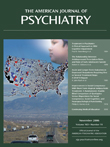EditorialFull Access
Published Online:1 Nov 2006
- Cited by
- 14 November 2012 | Cochrane Database of Systematic Reviews, Vol. 2021, No. 9
- 26 December 2012 | BMC Psychiatry, Vol. 12, No. 1
- 1 January 2008 | Statistics in Medicine, Vol. 27, No. 11
- 1 September 2007 | The Canadian Journal of Psychiatry, Vol. 52, No. 9
Metrics
History
Published online 1 November 2006
Published in print 1 November 2006



